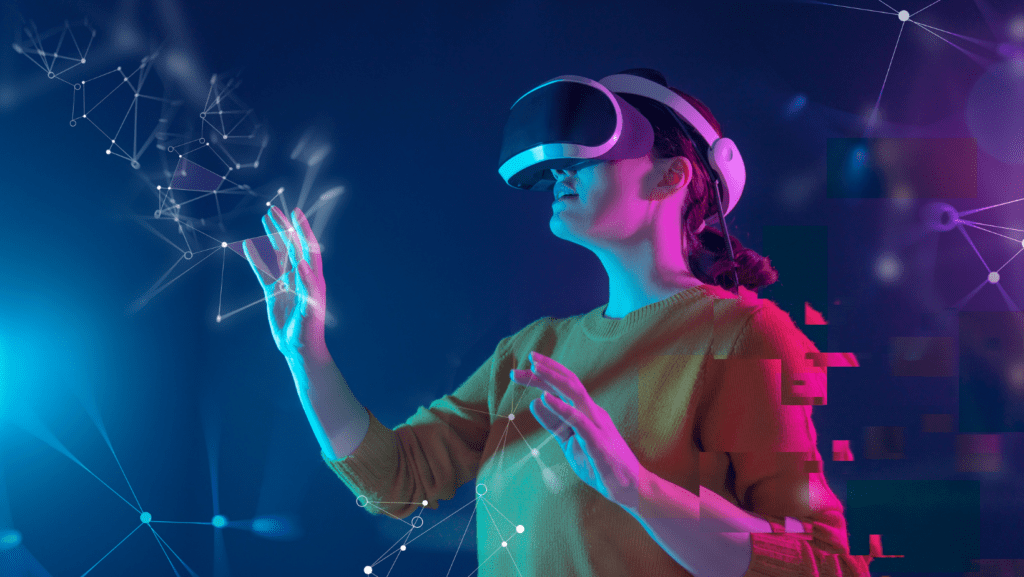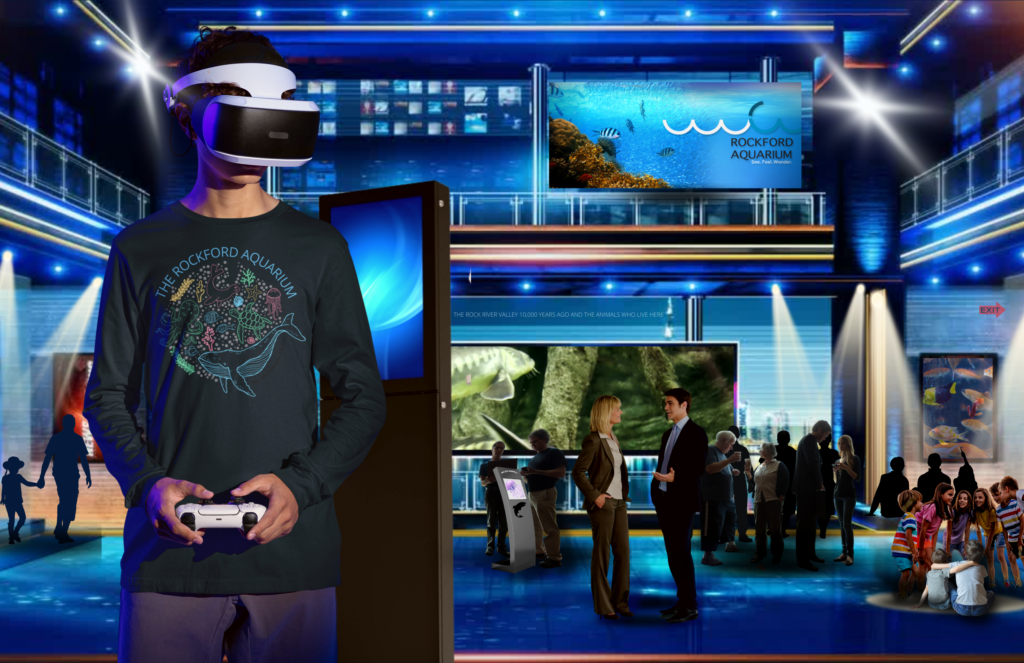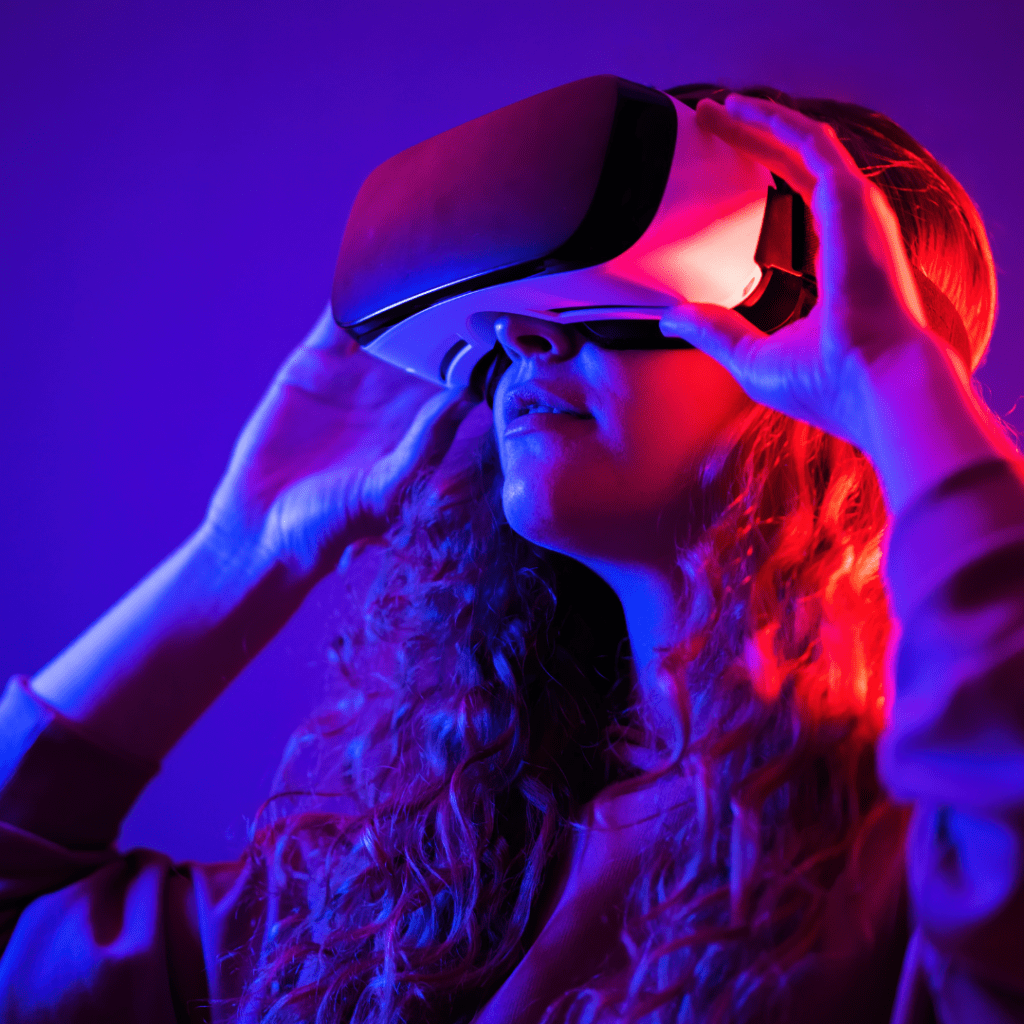
Incorporating the aquarium visitation loop into an augmented reality (AR) experience will enhance the visitor’s immersion and make the overall experience more engaging and interactive. Here are some ways the three stages of the visitation loop will be incorporated into an AR experience:
The pre-visit stage could be enhanced by offering a pre-visit AR experience. This could include an interactive map of the aquarium that allows visitors to preview exhibits and learn about the aquarium’s conservation efforts. Visitors could also be provided with AR-enabled guidebooks or brochures that use augmented reality to provide more in-depth information about the exhibits and animals.

The in-person visit stage could be enhanced by incorporating AR experiences within the exhibits themselves. For example, visitors could use AR-enabled devices to scan exhibit markers and see virtual animals or other interactive elements overlaid onto the physical exhibit. Additionally, AR experiences could be used to enhance educational programs and hands-on activities, such as virtual scavenger hunts or interactive games.
The post-visit stage could be enhanced by offering AR-enabled follow-up communication, such as virtual newsletters or social media updates that feature augmented reality elements. This could include virtual animal encounters or previews of upcoming exhibits or events.
By incorporating AR technology into the aquarium visitation loop, visitors could be provided with an immersive and interactive experience that enhances their overall enjoyment and understanding of the aquarium’s exhibits and mission. Additionally, the use of AR technology could help to attract new visitors and generate additional revenue for the aquarium.
AI can enable the AR system to recognize and track objects within the environment, such as animals or plants, and provide contextual information or animations. For example, an AR system with object recognition capabilities could provide visitors with information about a specific fish species as they swim by, or show how certain coral reefs have changed over time.
AI can be used to enable the AR system to understand and respond to natural language queries and commands. This could allow visitors to ask questions about the exhibits or the aquarium in general, and receive immediate responses from the AR system.
AI can be used to personalize the AR experience based on the user’s preferences, behavior, and history. For example, the AR system could recommend exhibits or activities based on the user’s interests, or provide personalized educational content based on the user’s previous interactions with the system.
AI can be used to analyze user behavior and provide feedback to improve the overall experience. For example, the AR system could analyze user engagement with specific exhibits or activities and make recommendations to optimize the visitor’s experience.
AI can be used to predict visitor behavior and make recommendations to improve the visitor’s experience. For example, the AR system could predict which exhibits or activities the visitor is most likely to enjoy based on their behavior and preferences and make recommendations accordingly.
AI can be used to provide real-time translation services for visitors who speak different languages. This could enable visitors from around the world to interact with the AR system and understand the exhibits in their native language.
AI can be used to analyze visitor data, such as behavior patterns, demographics, and interests, and make predictions about future behavior. This could help the aquarium to optimize its exhibits and services based on visitor needs and preferences.
AI can be used to monitor crowd movement and density within the aquarium and provide recommendations to improve crowd flow and reduce wait times. For example, the AR system could provide visitors with real-time recommendations on which exhibits to visit based on current crowd conditions.
AI can be used to enhance accessibility for visitors with disabilities. For example, the AR system could provide audio descriptions or sign language interpretation of the exhibits or provide wayfinding assistance for visitors with mobility impairments.
AI can be used to incorporate gamification elements into the AR experience, such as virtual scavenger hunts, quizzes, or challenges. This could make the experience more engaging and interactive, especially for younger visitors.
Augmented reality can be used to tell compelling stories about the aquarium, its history, and its aquatic inhabitants. For example, visitors could use an AR app to follow the journey of a sea turtle from hatching to adulthood or learn about the challenges of maintaining a healthy coral reef ecosystem.
Augmented reality can be used to create interactive exhibits that enable visitors to explore and learn about the aquarium in a hands-on and engaging way. For example, visitors could use an AR app to interact with virtual sea creatures, learn about their behaviors and habitats, and even simulate feeding and caring for them.
The concept of edutainment, which combines education and entertainment, plays a crucial role in creating an engaging and effective augmented reality experience. By incorporating educational content with interactive and entertaining elements, edutainment can make learning fun and engaging for visitors of all ages. There are several ways that the concept of edutainment can be employed in an augmented reality experience. Firstly, interactive exhibits can be created using augmented reality to enable visitors to explore and learn about the aquarium in a hands-on and engaging way. Gamification elements can be incorporated into the AR experience to make learning more fun and engaging. Storytelling can be used to tell compelling stories about the aquarium, its history, and its inhabitants. Finally, edutainment can be personalized to the interests and preferences of individual visitors. By incorporating the concept of edutainment into the augmented reality experience, the aquarium can create a more engaging, memorable, and effective learning experience for visitors. This can help to foster a deeper appreciation and understanding of marine life and the importance of conservation efforts, while also encouraging repeat visits and word-of-mouth promotion.

The integration of AI into the metaverse experience has the potential to revolutionize the way we learn about and engage with marine conservation and education. By providing personalized and interactive experiences that are both entertaining and educational, the metaverse can help to inspire a new generation of ocean advocates and conservationists. However, it is important that we approach this technology with a critical and ethical lens, and work to mitigate the potential risks and challenges associated with its use. By doing so, we can create a metaverse experience that is truly transformative, engaging, and inclusive for all visitors.
In the future the Rockford Aquarium will use immersive educational, and entertainment exploration, commonly described as entertainment. The aquarium’s metaverse will, at its core, be a collection of new and extended technologies. The metaverse is the realm of computer-generated, networked immersive reality, that embraces all aspects of augmented reality, mixed reality and virtual reality commonly identified as AR, MR and VR.
The metaverse experience will be built around a variety of immersive technologies, including augmented reality (AR), mixed reality (MR), and virtual reality (VR). AR technology will be used to enhance the real-world aquarium experience by overlaying digital content onto the physical exhibits, enabling visitors to learn more about marine life in a hands-on and interactive way. For example, visitors could use an AR app to scan a QR code on an exhibit to learn more about the animals on display, watch educational videos, or participate in interactive games.
At the heart of the metaverse experience is the idea of immersion. By creating a fully immersive environment that combines education, entertainment, and exploration, the Rockford Aquarium will be able to create a powerful and memorable experience that inspires visitors to learn more about marine life and conservation efforts. The metaverse experience will be designed to be flexible and scalable, enabling it to adapt to the changing needs and preferences of visitors over time.


The Rockford Aquarium’s metaverse experience is not only an exciting development for visitors, but it also has the potential to transform the aquarium industry as a whole. By embracing immersive technologies and creating a fully integrated digital experience, the aquarium is setting a new standard for visitor engagement and education.
One of the key benefits of the metaverse experience is its ability to provide visitors with a personalized and interactive learning experience. Through the use of AR, MR, and VR, visitors will be able to explore and learn about marine life at their own pace, in a way that is tailored to their individual interests and learning styles. This personalized approach to learning has been shown to be highly effective, as it allows visitors to engage with the material in a way that is meaningful to them.
A further benefit of the metaverse experience is its potential to reach a wider audience. By creating a digital experience that can be accessed remotely, the aquarium can extend its reach beyond its physical location and engage with audiences all over the world. This is particularly important in the context of marine conservation, as it enables the aquarium to raise awareness and educate people about the importance of preserving our oceans and marine life.
The metaverse experience has the potential to revolutionize the way aquariums approach conservation efforts. By leveraging immersive technologies and digital platforms, the aquarium can create educational experiences that inspire visitors to take action and get involved in conservation efforts. For example, visitors could participate in virtual beach cleanups, learn about sustainable fishing practices, or even donate to marine conservation organizations through the metaverse experience.
The metaverse experience also has the potential to generate new revenue streams for the aquarium industry. By creating a digital experience that can be accessed remotely, the aquarium can tap into new markets and generate revenue through digital ticket sales, virtual events, and other digital offerings. This can help to diversify revenue streams and ensure the long-term sustainability of the aquarium industry.


One key opportunity is the ability to gather valuable data and insights about visitor behavior and preferences. By tracking how visitors interact with the digital experience, the aquarium can gain a better understanding of what content and features are most engaging and effective. This data can then be used to further refine and personalize the experience, as well as to inform decision-making around exhibit design, programming, and marketing.
Another potential benefit of the metaverse experience is its ability to facilitate collaboration and partnerships between the aquarium and other organizations. For example, the aquarium could partner with marine conservation organizations, academic institutions, or even other aquariums to create joint programming or exhibits within the metaverse experience. This could help to expand the scope and impact of the aquarium’s educational and conservation efforts, while also fostering collaboration and knowledge-sharing across the industry.
The metaverse experience also has the potential to promote accessibility and inclusivity for a wider range of visitors. By incorporating features such as closed captioning, audio descriptions, or haptic feedback, the aquarium can make the digital experience more accessible for visitors with disabilities or other special needs. Additionally, the digital experience can be designed to appeal to a broader range of ages, interests, and learning styles, which can help to attract and engage a more diverse audience.
The metaverse experience can serve as a platform for innovation and experimentation within the aquarium industry. By embracing new and emerging technologies, the aquarium can push the boundaries of what is possible in terms of visitor engagement, education, and conservation. This can help to keep the industry dynamic and relevant, while also inspiring and empowering the next generation of marine conservationists and enthusiasts. The Rockford Aquarium’s metaverse experience represents a bold and exciting step forward for the aquarium industry, with the potential to unlock new opportunities and benefits for visitors, organizations, and the environment. By embracing immersive technologies and creating a fully integrated digital experience, the aquarium is positioning itself as a leader in the industry and paving the way for a more sustainable and engaging future.
The visitor to the Rockford Aquarium, will have a fully digital, computer-generated three-dimensional experiential environment, to interact with on a myriad of interactive water experiences. As artificial intelligence gets into the immersive mix, visitors can expect even more personalized and engaging experiences. AI-powered chatbots and virtual assistants can be integrated into the metaverse experience to provide visitors with real-time information, recommendations, and assistance. For example, a visitor might ask a virtual assistant for more information about a particular species of fish, or request directions to a specific exhibit. The virtual assistant could then provide a personalized response based on the visitor’s interests, preferences, and location within the metaverse.
Another way that AI can enhance the metaverse experience is through predictive analytics. By analyzing visitor data and behavior patterns, AI algorithms can predict what content, exhibits, or experiences are most likely to appeal to a particular visitor. This can help to guide visitors through the metaverse and ensure that they have a customized and engaging experience.
AI can also be used to power interactive exhibits and simulations within the metaverse. For example, visitors could use AI-powered tools to explore the effects of climate change on marine ecosystems, or to design their own virtual aquarium exhibits. These interactive experiences can not only be entertaining and educational, but also foster a deeper understanding and appreciation of marine conservation issues.
However, as with any technology, there are also potential risks and challenges associated with the integration of AI into the metaverse experience. Therefore, it will be of paramount importance for the Rockford Aquarium always carefully consider the ethical, social, and environmental implications of AI integration within the metaverse experience. By doing so, we will ensure that AI is used in a responsible and beneficial way that enhances, rather than detracts from, the overall visitor experience and the goals of marine conservation and education. To mitigate these risks, it will be important to ensure that AI systems are trained on diverse and representative data sets, and that they are regularly audited and tested for bias and accuracy. Additionally, it will be important to involve diverse stakeholders in the design and implementation of AI-powered exhibits and experiences, to ensure that they are inclusive, culturally sensitive, and accessible to all visitors.
Overall, the Rockford Aquarium’s metaverse vision represents a bold and innovative approach to aquarium design that leverages the latest immersive technologies to create a truly engaging and memorable experience for visitors. By embracing the power of AR, MR, and VR, the aquarium will be able to create a fully immersive environment that seamlessly blends the real and digital worlds, enabling visitors to explore and interact with marine life in a way that is both educational and entertaining.


By embracing the latest immersive technologies and creating a
fully integrated digital experience,
the aquarium is setting a new standard for visitor experiences
and positioning itself as a leader in the industry.